On The Record with Todd Clapper of Arizona State Women’s Water Polo
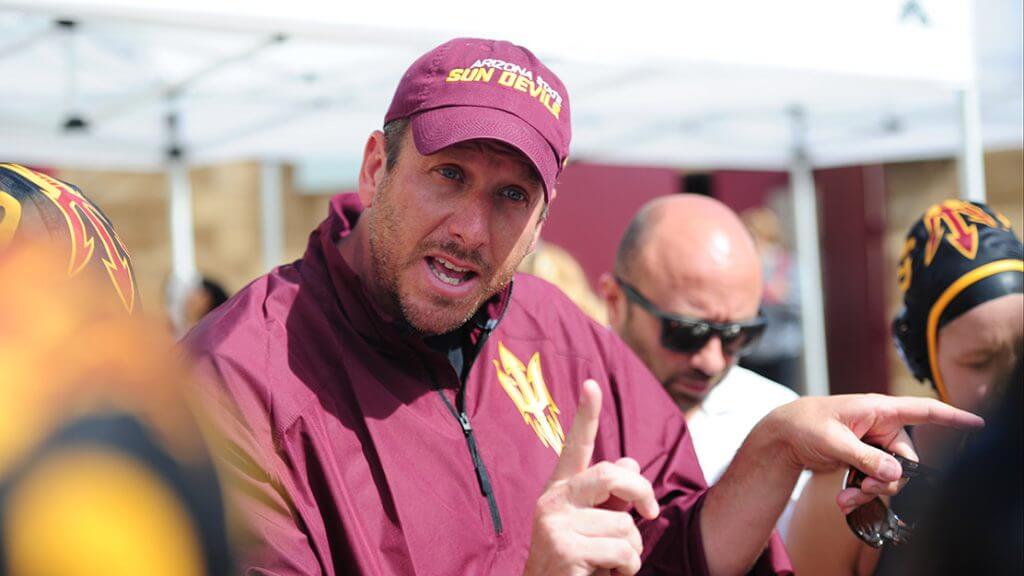
By Michael Randazzo, Swimming World Contributor
Editor’s Note: this month Swimming World opens its coverage of the 2018 NCAA Women’s Varsity Water Polo season. Look for interviews, conference predictions and the best coverage of the sport in America and beyond.
Speaking with Todd Clapper, head coach for the Arizona State women’s water polo team, is a tutorial of how the sport works at the highest levels of NCAA varsity polo. Blunt and incisive, Clapper has earned every ounce of the considerable success he’s achieved.
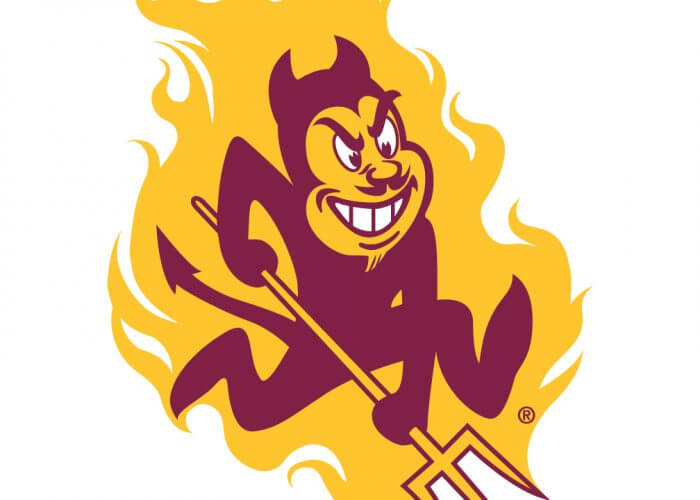
A walk-on to Richard ‘Doc’ Hunkler’s Slippery Rock program, he deftly climbed the coaching ranks from high school in Pennsylvania to Brown University to Arizona State in the Mountain Pacific Sports Federation (MPSF)—and along the way developed coaching and recruiting philosophies that have allowed the Sun Devils to join the upper echelons of U.S. women’s varsity polo. Since arriving in Tempe in 2005, his record as head coach is 199-126, including trips to the NCAA tournament in 2014 and 2016.
Clapper’s 2018 team may just be the best in program history. Anchored by Mia Rycraw—arguably the top goalie currently playing college polo in America—and a core of international players headlined by Bente Rogge (Holland), Lena Mihailovic (Serbia) and Alkistis Benekou (Greece)—the #5 Sun Devils (3-0) hope that a fast start will translate into success when they open MPSF play on March 17 versus Cal.
During an early season lull as he prepares his team to host four teams in the ASU Cross Conference Challenge—including #6 Hawai’i—Swimming World caught up with Clapper about how he honed his coaching craft, the challenge of battling the country’s top squads for an NCAA berth, the influx of foreign talent that is transforming American polo and the incomparable Rycraw and her Olympic dreams.
– How did you get started playing water polo?
I grew up about 40 minutes away from Happy Valley, PA in the Altoona-Hollidaysburg area. I have three older brothers and I tagged along with them. Our parents got us all in on swim lessons when we were young—I was a competent swimmer.
My junior year in high school, one of my good friends said: “We only have seven guys on the swim team—and we need eight for relays. Will you join us?” I said “Ok,” and started swimming. I wasn’t fast but my times dropped and that was okay.
[In 1993] I decided to go full time at Slippery Rock. I didn’t know anybody there so I thought I’d go there early, talk to the swim coach [thinking] its Division II, maybe I can walk on the swim team.
I ran into a water polo player who was lifeguarding at the pool—I’m pretty tall—who told me they had a small roster and their coach regularly takes walk-ons. Was I interested in playing polo? He introduced me to Doc Hunkler.
That first year was whirlwind, learning so much. I was fortunate enough to be able to travel, so I got to watch us play games. I never saw any game-time.
Our goalkeeper was graduating in December and the position was wide open. One of the things I was pretty good at was blocking in 5-on-6 [situations], so I decided to move into goalkeeper. By the middle of my sophomore year I was starting in the goal, and was the starter the rest of the time I was there.
[After graduating] I was helping Lilah Al-Masri coach with the Villanova women’s team. I had known Lilah from playing masters [polo] together. She invited me to coach the goalies, so I did that while I was working a full-time job.
I realized after that I didn’t want to stay on the same trajectory I was on. When I got the opportunity to coach high school polo at Wissahickon [a Philadelphia suburb] I thought: “I don’t know what I’m going to do after the season but let’s focus on this.”
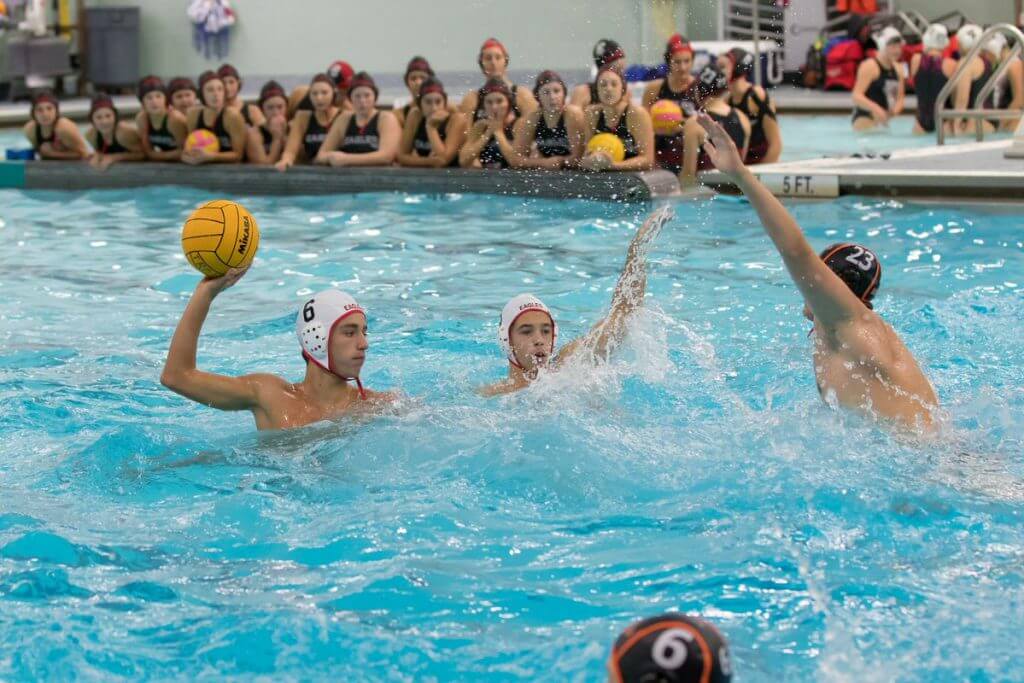
Pennsylvania High School Water Polo.
– Water polo is a state sport in Pennsylvania; how does it compare on a national level?
There are certain pockets [of polo] around the country, Pennsylvania being one of them—they have some varsity programs, they’ve got club going on, but they’re isolated. You see these coaches who have been around for a while, and what they’re doing gets them to the state championship game, but maybe they’re not seeking out the opportunities to learn and grow that they did 10-15 years before.
There’s some really good polo and some good, passionate coaches but, like a lot of places, they have this geographical obstacle in the way of being influenced.
In the Pittsburgh area you’ve got Nikola Malezanov who’s done a really good job growing water polo in the area from scratch. Then you’ve got Cumberland Valley which benefited from a lot of people playing masters there. And you have some other pockets like Souderton, where programs have continued to be strong.
Nikola works with on the men’s national team for USA Water Polo [coaching the cadets] so he’s able to stay up with the game. That’s the challenge in a lot of these areas; they just don’t have the opportunity for professional development.
– At Slippery Rock you were coached by Doc Hunkler. What makes him distinctive as a coach and as a person?
Obviously, I learned a lot about the game from Doc. At one point Alan Huckins and Tim Hugar.
were there and those guys taught me a lot too. One of the things that stayed with me from Doc is he really had a great balance. He could be tough on you but you always knew that he really cared about you. He wants you to succeed. The way he would do that [was] pushing hard on you, setting a standard, but doing it for all the right reasons. He was one of the most selfless guys that I’ve ever known.
– Taking the job at Brown set you on your coaching career.
You look back on your life and you realize there were risky decisions that you make that somehow pay off. [Coaching at] Brown was one of those things. They were turning the women’s program from club to varsity and it wasn’t paying much, but I figured out I could live [off the salary].

I decided to do it. It’s a college job, a great opportunity and a brand-new program. I was a new coach and really raw; it was a great way for me to cut my teeth on coaching and running a program. Then, Erik Farrar, who was the men’s coach, resigned [in 1999] and they were able to put the positions together, so I was now coaching the men.
I was really young in the sport—age-wise and from a coaching standpoint. Bit I was able to work through certain things, and there were things I took from Doc in terms of trying to inspire the team.
I think I was successful on the women’s team, and [attempts to inspire were] probably more successful than tactics in winning an Easterns Championship in 2001.
Coaching men and women, I was there five and a half years but I coached 11 seasons of water polo. That was an instrumental part of my development. It gave me a good foundation to take another step.
– As you forged a career path, what helped you develop the coaching skills that led to success at Arizona State?
A lot of coaches don’t even know where to look [for professional development]. Now I’m fortunate to be in a position where I know where to look. I know where to go to learn new things.
After my first spring at Brown, I decided that if I was making a career out of this, I need to work. I need a plan, here are the obstacles in my way. How can I improve? I reached out to Mike Schofield, who ran Navy Camps and was the Navy head coach and asked for a spot [at one of his camps]. I realized I needed to get around people to coach, to practice and to learn.
At the same time I was there, Ferenc Vindisch—he coaches in Victoria [Canada] at Saanich—was there. A Hungarian, he coached Tamas Kasas when he was young. [He was] a really experienced coach in terms of technical skills. He runs week-long camps in Victoria, so I worked one week of his camp up there. Those two—Schofield and Windisch, in addition to Doc—became mentors who helped develop a lot of those things along with some other people who were just very generous. Randy Burgess down in Coronado, Pete Snyder out in Fullerton. They saw that I wanted to learn and they were willing to help.
And that’s the contradiction, right? [Water polo in America] lacks professional development but then you have all these really great people willing to help. There’s a barrier to entry; some people just don’t feel comfortable asking. And there’s not a very straightforward [approach] to taking education classes. You have to know someone who knows someone or be comfortable picking up the phone and saying: “Hey, can you help me?”
– Talk about the transition from Brown, a leafy New England campus, to Arizona State, a sunny educational mecca in the Southwest.
I got to a point at Brown where I realized that job was only going to be [what it was]; the Athletic Department was comfortable with the support they were giving the program at that time.
I had an opportunity to run youth water polo out of the city of Henderson [Nevada] rec programs. There had been water polo there before from Sandy Nitta. I got some things going and thankfully Sandy got back involved, and she’s taken it to levels I probably never would have because she’s extremely invested in that.
[In 2004] I got an email from Vicki Gorman [at Arizona State] that her assistant coach was leaving. I went out for an interview and just fell in love with the campus and with Pac-12 support. I could continue to coach outside—which was new being from the East Coast—and I thought maybe I’d get a master’s degree and I learn from Vicki. And, being on the West Coast, I was now closer to professional opportunities, maybe with the national team because I’m not so far away.
I think what Vicki really loved about coaching was the teaching aspect, and there’s part of that here. At Brown, you weren’t evaluated every time you went out and played. It was different. There were games that were really close, there were games that were blowouts—so you’re not evaluated every time you go out. At ASU, every time you go out it’s an evaluation.
I was fortunate that when Vicki left, Don Bocchi, a senior administrator, went to bat for me. They gave me a year and said: “Let’s see what you can do for a year.” I was fortunate enough to do well that first season [15-13] and got a contract after that.
– There’s no question that the polo played in the MPSF is by far the best in the country.
In our conference, if you’re going to win a conference championship, you’re probably one of two teams that’s the favorite to win the NCAA Championship. So every time we go out, if we take a loss from a team that’s even in the hunt or on the bubble with us or that’s lower in the rankings, that better be early in the season. Because late in the season you may not recover you may not recover [in time] for one of the [NCAA] at-large bids, and it’s so hard to get one of those and get into the tournament.
– Talk about this year’s team. The Sun Devils are picked for fifth in your conference; how can you position your team for an NCAA berth?
When we look back at the times that we made NCAAs and the times that we haven’t, I can typically point to one game. Two or three times, that game has been at the MPSF Championship. So many times in that final weekend it comes down to one game; we have a great resume, maybe five losses through the season, and our postseason hopes are hanging on one game at MPSF Championships against a team that we split with earlier in the year.
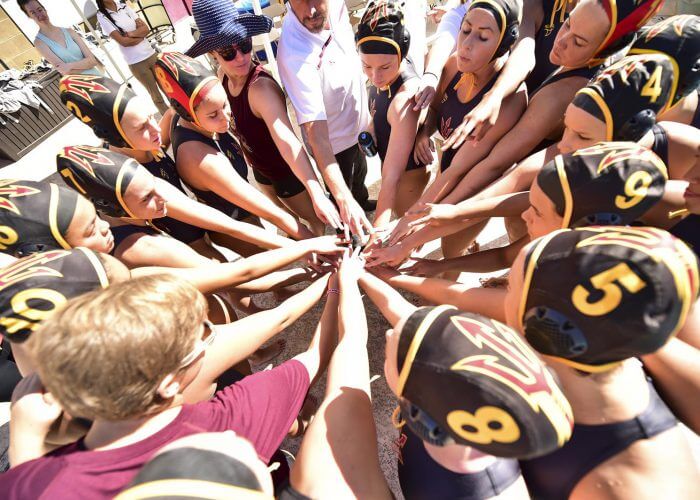
Photo Courtesy: Arizona State Athletics
You’ve got to perform in that one game even though you’ve had a wonderful season up until that point.
In 2016, when we got in, it came down to us, Cal and Hawai’i. Hawai’i lost their conference, and the two losses Cal had [to them] was a huge factor, as was our win against Michigan. We squeak in, even though we lose to Cal in MPSF at the end of the season. Two years earlier in 2014 we got in from upsetting [Southern Cal] in the opening round of the MPSF Championship.
– That prompts the question: which game this year do you expect will determine your team’s NCAA fate?
You look at the rosters—UCLA, USC, Cal and Stanford—and they’re all pretty strong. I’m taking a bit different philosophy right now; for us to beat any of those teams, [we talk about] the things that we can affect with our team every day.
I’m trying not to repeat past mistakes. I’m saying this is how we have to change our training program to be better prepared for that. We’re a better team when we have time to watch video and have a week to prepare for one game rather than in a tournament setting. If we can finish top four before the Irvine tournament and before the conference season starts, that starts us out ahead of the game for the [NCAA] at-large [berth]. It puts us in a good position to then utilize our strength, breaking down the teams by video and preparing for one game on the weekend.
When we get to the Irvine Tournament [February 23-25], we want to be in position—we’ve got a big weekend coming up with Hawai’i at home [February 2-4], which will be a deciding factor in our ranking, and then the Triton Invitational [February 10,11]. If we can hold at least the #5 ranking if not go up, and we win that first game, then we go into whomever that fourth-ranked team is and if we put ourselves in a situation to pick off that team, that’s the lower hanging fruit [of the season].
We’ve only been in the top four [going into] Irvine once. The rest of the time we’re just battling through to that fifth ranking.
– You have a core of foreign players, a formula repeated not only in the MPSF but throughout NCAA women’s varsity polo. Is this good for the sport in America?
It comes down to: these are the players, at least in terms of level and commitment, that are going to our competitors. In the U.S.—there are players outside of California too—we’re casting a very wide net and casting a wide net globally. We try to find the best players with the best attitude, the best commitment to the game that we can find wherever they are. Sometimes it’s not the best in the U.S., sometimes it’s not the best water polo player; it’s the best athlete with the commitment where we find they can slowly develop into somebody who we’re relying on, even if it’s for a couple of minutes a quarter, and stretching those eight scholarships out to put together a team that’s talented and deep enough to win a national championship.
I know there are people that believe [importing] international athletes are hurting the game. They don’t like it; they think that it’s taking opportunities away from the best U.S. players.
I say, if there are more U.S. players who are as committed to the sport as these international players who are trying to rise through their national teams, playing 12 months a year, there would be more American athletes in those positions.
– Could a better job be done providing direction—and structure—for those U.S. prospects who do want to develop as much as their international counterparts?
A pride point of our team is diversity. Whether that’s ethnic diversity, whether that’s geographic—that’s one of the things we really pride ourselves on. We want our team to look like the world. For me that’s very important. It’s also something that our players have embraced. We give them an experience that’s perhaps different than what they would have gotten at other universities.
As this relates to recruiting in the U.S., there are kids—outside and inside California—that really have to work to seek outside opportunities to train. Because they’re not close to somewhere really easy to get to. There’s people in California who are driving an hour each way to go train with the best coach they possibly can find in their area. There’s kids in Florida and Texas seeking out every opportunity possible to train, and to play and to elevate.
This is the type of mentality that we’re looking for. There are a lot of kids that take advantage of the opportunity that they have—it’s not just water polo, it’s in every aspect of life. They don’t realize how easy it is for them compared to those people who are driving an hour each way.
I don’t care where the kid comes from; they could come from Orange County, they could come from Mars. I want an athlete who’s committed. And if that kid’s also a really good and experienced water polo player and wants to come to ASU, well then, we’ve got a scholarship for that kid.
What I’m not going to do is offer a scholarship to a kid who’s a risk. A risk whether I don’t know if they’re committed, I don’t know that their motivation for playing the game is, or how good they’re going to become.
Most coaches are going to tell you that you can’t spend a lot of money on risks because most of the time it’s not going to work out.
It’s a very easy excuse to say that the international player is taking away the scholarships—it’s like South Park: “Taking our jobs!” It’s like the people shouting that!
Qualified people get scholarships. If a kid from Orange County or from anywhere in California or in the U.S.—if that kid is qualified based upon the same criteria as Bente Rogge from Holland who is on her senior national team and is one of the best college polo player in the U.S. right now, in my opinion… If you’re that kid coming out of high school, you’re going to get a scholarship anywhere you want in the country.
If you’re not that kid, work to be that kid. Because that’s who you’re competing against.
And if you’re not able to compete, don’t ask for any special help because you were born in America. This is who your competition is: the best players in the world.
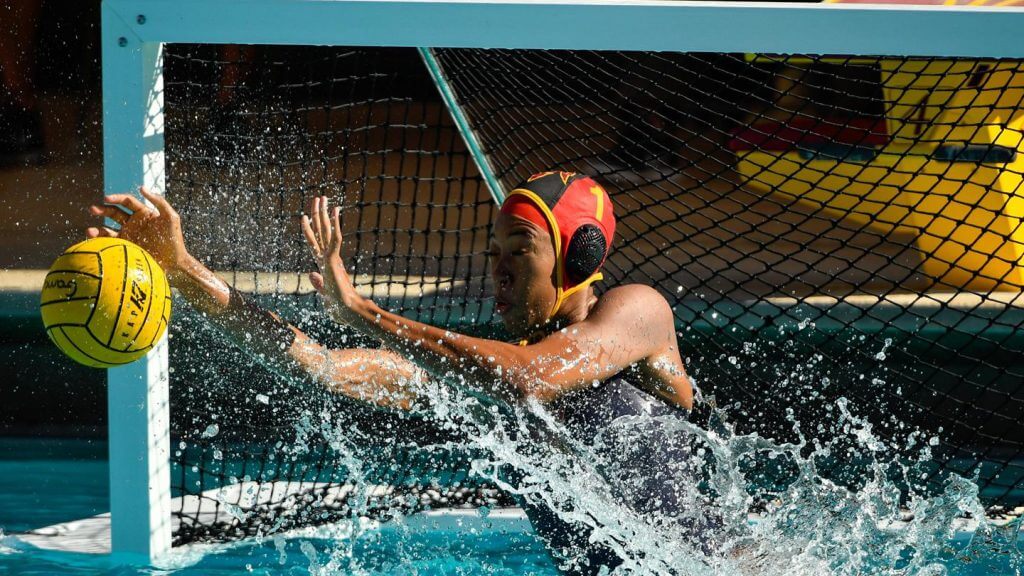
Mia Rycraw. Photo Courtesy: Arizona State Athletics
– On the ASU website, Mia Rycraw is quoted as saying: “My goal is to go to Olympics in Japan in 2020.” What will it take for her to realize this goal?
In my opinion, and other people share this opinion, in college water polo right now, this season, Mia Rycraw is the best goalkeeper. Amanda Longan [of USC] is really good—not to take anything away from her—she’s now with the national program.
In my opinion, Mia’s the best goal-keeper, and on her best day she’s better than anyone else’s best day. So as a result—and because it’s a young sport—Mia has a really good opportunity to be in the mix for the 2020 Olympics.
What happens sometimes is you aren’t in the national program, you get in the national program, and you don’t really understand what that involves in terms of another level of life commitment.
It doesn’t matter how tired she is or how she feels. This is her goal and every day it’s a lifestyle.
[Rycraw] got an opportunity to train last summer, she went to a World League Super Final, she went to University Games. She’s really good and she’s training really well right now, she was excellent last weekend.
But there’s a certain amount of: Put your head down, train hard and make a lifestyle commitment to being an Olympian. She’s talented enough and she can get there—Ashleigh [Johnson] is really, really good, and I’m not saying the Mia is better than Ashleigh right now—she could push Ashleigh, and maybe Ashleigh’s experience wins out, but she could be a clear second. If she embraces that it’s a different level of commitment.
She’s getting there but it’s a challenge.
– Because they need teams, the MPSF just invited Austin College to join their men’s water polo bracket. What are the obstacles to bring men’s polo into a program like yours?
I’ve got a really simple answer: $10 million dollars. And I’m not making a joke, either. Our AD [Ray Anderson] has had a conversation with USA Water Polo. He really wants to add sports—we’ve added a ton since he’s gotten here. You have some issues; you want to make sure that you don’t set yourself in a situation where you upset the balance of gender equity at your university.
So you can’t just fund men’s polo, you also have to choose a women’s sport you’ll add to make sure that you’re providing the same number of opportunities to both men and women.
The other thing is that no Pac-12 institution is going to add a sport bare-bones. If you’re going to add a sport you’re going to want to do it right. You want to compete and become a national contender.
You’re going to add it to win!




ltnc, thx for posting
GREAT article about a coach who understands D1 Athletics … super proud our daughter chose ASU!
Dear Sid:
Thank you for your comments. I thought that this was a particularly strong interview because Coach Clapper was so direct. I particularly appreciated his comments about foreign-born athletes in NCAA varsity polo.
All the best to your daughter in her time as a Sun Devil!
Your correspondent.